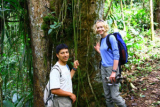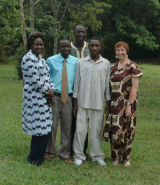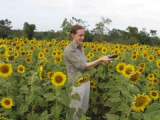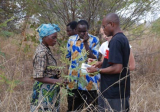

Theo Hills (1925-2002) served McGill as a Professor of Geography from 1950 until his retirement in 1992. He was a pioneer in the study of sustainability and the developing world. In the mid-1950s Professor Hills helped build a research station in the Rupununis of Guyana. This eventually led to the creation of McGill's Centre for Developing Area Studies, where he served as Associate Director and later Director. He was pivotal in the development of the Bellairs Research Institute in Barbados, Canada's only university tropical research centre. Professor Hills was also very interested in his own community; he conducted studies in Quebec's Eastern Townships and worked closely with several aboriginal communities on the issue of land claims.
To commemorate his substantial contribution, McGill, by the initiative of the family and friends of Theo Hills, has established the Theo L. Hills Memorial Fund, an income generating endowment which helps support graduate students' field-work research in developing areas. If you would like to contribute to this initiative, you may do so over the phone by calling (514) 398-3128. You can also send a cheque payable to McGill University (please write "Science - Theo L. Hills Memorial Fund" on the back or on the memo line). You may mail your cheque to:
Robert Davis, McGill University, 3450 University street, Frank Dawson Adams Bldg, Room 23, Montreal , Quebec H3A 0E8
For more information, please contact Robert Davis, Director of Development at (514) 398-3128 or rob.davis [at] mcgill.ca .
Recent Theo Hills Memorial Fund awardees:

2013, Bernard Huber
The Environmentality of Forest Conservation in two ethnic Hmong villages in Yen Bai Province, Vietnam
My PhD research is a social science study of forest conservation in Vietnam, where since the 1990s many Protected Areas have been established. As elsewhere in the developing world, national and international conservationists have paid too little attention to the livelihoods of local and indigenous peasants, often unfairly portraying them as the main culprit for forest destruction.
Therefore, I investigate how forest conservation is institutionalized and governed in the Mu Cang Chai Species and Habitat Conservation Area, as well as how the restriction of forest use has affected the subsistence livelihoods of poor peasants in two remote buffer zone villages. In addition, I seek to understand how villagers understand and comply with the forest conservation project, as such Protected Areas can only be successful if local villagers support the objectives and can derive some benefits from them. Different models of Payment for Environmental Services (PES) have been implemented around the world to compensate villagers for lost forest access and acknowledge their contribution to forest protection. Interestingly, the socialist government of Vietnam has been very proactive to pilot PES models, and villagers in my case study villages are dependent on these payments. Through this research, I hope to generate policy recommendations for sustainable forest conservation and PES in Vietnam, as well as more conceptual contributions to the nexus of conservation and development.
My fieldwork takes place in two villages in Mu Cang Chai district, Yen Bai province, in the northern highlands of Vietnam. I live in these villages for several weeks at a time and interview villagers and local officials, in addition to key informants in the district town and in the capital of Hanoi. Such village studies are very rare in Vietnam, and I am very fortunate to have gained the trust of my host institute and local officials to let me do this fieldwork. As a family father, I can only spend two months at a time in Vietnam and I am undertaking a total of six trips between November 2011 and May 2014, which is also methodologically proving very effective. Other fieldwork expenses surpass those of the airfares and include costs for local transport, food, accommodation, translators, Vietnamese language training, mandatory affiliation with my host institute, and compensation for research participants. I am very happy to have received the Theo Hills Award to absorb some of these costs and I would like to thank you very much for your generosity. The mission of the Theo L. Hills Memorial Fund to support student fieldwork in the Global South is very important, and I feel very honoured to be one of the recipients of this award.

2012, Gillian Gregory
Shifting Livelihood Strategies and Resource Use by Ribereños on the Amazon Floodplain: What are the links between human migration, resource use, & conservation efforts in Peru’s Pacaya Samiria National Reserve?
My research looks at the relationships between rural-urban migration, aquatic resource management, and possibilities for conservation in the Peruvian Amazon. The first goal of my research is to identify migration patterns between rural and urban areas on the Amazon floodplain in Peru, including how and why people move. The second goal is to understand the impacts of rural-urban migration on the ways rural people use and manage natural resources in a major conservation priority area, the Pacaya Samiria National Reserve.
In 2011, I visited 12 communities surrounding the Pacaya Samiria National Reserve in order to understand the frequency with which families and/or individuals migrate as well as more detailed information about their daily livelihoods in these rural areas. I also spent time in the urban centre of Iquitos, interviewing migrants from these rural communities about how their livelihoods have changed since moving to the city. This preliminary field trip allowed me to refine my study focus and select study communities, as well as establish contacts with local universities, research institutions, NGOs, and future field assistants.
This year, I will use the Theo Hills award to help support a longer period of field research in Peru. I will be working intensively in two study communities surrounding the Pacaya Samiria Reserve, as well as urban centres in and beyond the Amazon. In the rural communities, I will conduct household surveys and interviews, as well as obtain estimates of some seasonal resource harvests. In the cities, I will again conduct interviews with migrants from the communities. Ultimately I hope this research will contribute to better understanding resource management and possibilities for conservation on the Amazon floodplain, taking into account the contemporary context of frequent migration and rapid urbanization.

2011, Bernard Huber
The Environmentality of Forest Conservation in a remote Hmong village in Yên Bài Province, Vietnam
Along with its economic and political reforms of the 1990s, Vietnam implemented new programs for reforestation and forest conservation, following decades of poor forest management and rampant deforestation. To protect the remaining forest biodiversity, international conservation agencies helped establish 122 Protected Areas, which, however, have often relied on ‘fences and fines’ and have negatively affected subsistence peasants that had traditionally relied on forest resources for their livelihoods. The Hmong are one of 30 different ethnic groups that live in Vietnam's northern highlands and were traditionally shifting cultivators and hunters.
In a remote Hmong village bordering a recently established Protected Area, my research investigates (i) how forest conservation has been instituted in this village; (ii) how villagers have adapted their livelihoods to new land-use regulations; and (iii) how villagers’ attitudes towards forest use and biodiversity conservation have developed. Through my ethnographic study of conservation enforcement, livelihood transitions, and environmental attitudes, I aim to contribute to our understanding of conservation conflicts, and how subsistence livelihoods can be managed sustainably.
My research requires several trips to Vietnam, 10-12 months of fieldwork in the highlands and in the national capital, Vietnamese language training, as well as the hire of both Vietnamese and Hmong interpreters. Therefore, I am very grateful for the financial contribution of this award and I sincerely respect the commitment of the Theo L. Hills Memorial Fund to help fund graduate student fieldwork in developing countries.

2010, Sarah Wilson
Tropical cloud forest restoration: Can biodiversity and community needs be reconciled?
My research looks at how and why NGO-led reforestation projects affect rural livelihoods, forest use, and tree and orchid diversity in cloud forests in the Andes of Northwest Ecuador. Over the last two decades, local and international NGOs have initiated several community restoration projects in this region, largely to protect the high levels of endemism and biodiversity found there. In May and June 2010, I used the Theo Hills award to visit seven farming communities in this region where farmers are reforesting land on either community reserves or private land. In these communities I ran focus groups and interviewed farmers to learn more about past and present forest use, reforestation techniques, and farming practices. During this time I stayed with farming families, worked with local field assistants, and learned a great deal simply through informal interactions with people in the community.
I used the information from this preliminary field trip to refine my research questions and methods to suit the region and individual communities. In addition, during this visit I established contacts with local research institutions and herbariums, local researchers, and future field assistants. I will return to each of these communities in 2011 to conduct household surveys, measure forest diversity in restored and natural forests, and study forest cover change in the region using remote sensing. Ultimately, I hope my research will add nuance to some common oversimplifications about forest restoration. I also hope it will help guide community forest restoration efforts in two ways: by helping people prioritize when to use tree planting to restore forests instead of natural regeneration; and by looking at how reforestation affects local people, so that the negative impacts can be minimized and the positive elements emphasized in future restoration projects.

2009. Catrina MacKenzie
Perceived benefits and losses of living near the Kibale National Park, Uganda.
My research aims to answer the question; ‘For the people living in communities that directly border Kibale National Park, Uganda, do benefits and losses accrued as a result of the existence of the national park, affect their conservation attitudes and behaviours?’ This requires creating an inventory of the perceived benefits and losses accrued in 25 villages located directly adjacent to the park. These benefits and losses will then be correlated with physically measured levels of illegal resource extraction inside the park near each village.
In 2008-9 my Ugandan field assistants and I ran focus groups and carried out household surveys in the 25 study villages to understand what the primary benefits and losses are that local people accrue as a result of the existence of the park. Benefits included higher levels of rainfall close to the park, perceived as a significant benefit for farming, and the revenue sharing program in which 20% of park entrance fees are shared with local communities for infrastructure, crop raiding defense and income generating projects. The primary loss was destruction of their crops by wild animals, especially elephants that live in the park and then raid local village gardens for food. This year, my Theo Hills award will be used to hire a local person in each of the 25 villages to record and document crop raiding incidents so that the magnitude of the crop raiding problem can be determined for my research, but also to make crop raiding visible to local authorities and to determine the most affected villages. This knowledge may help the Ugandan Wildlife Authority and local government officials to plan and fund crop raiding defenses such as elephant trenches

2008. Elizabeth Heller
Agricultural intensification and landscape structure in the Malaprabha watershed, Karnataka, India
My research is focused on the relationships between farming practices and landscape structure, in the context of agricultural intensification in southern India. Over the past forty years, agricultural intensification in the Malaprabha watershed in Karnataka state, India, has been accompanied by increased irrigation and major changes to crop rotations. At the same time, average farm size has been declining in the area, possibly affecting elements of landscape structure, such as field size. The relationships between field size and farming practices may have important implications concerning the impacts of agricultural intensification on ecosystem services.
My research will use multiple, Landsat-type satellite images to map land use in the watershed in 2007, differentiating between major crop groups and between irrigated and non-irrigated areas. Extensive ground-truthing will be used to support the remote sensing data. Additionally, high-resolution imagery and interviews with farmers will be used to investigate the relationships between farming practices, field size and ecosystem services, as indicated by the number of trees and hedgerows in the landscape. I hope my research furthers understanding of the important interactions between farming practices, landscape diversity, and farmer livelihoods, which will potentially have implications for the ultimate stability and vulnerability of these changing agro-ecosystems.

2007. Maro Adjemian
Medicinal Plant protection and deforestation in rural Zambia
During the summer of 2007, I spent just over three months in rural Zambia completing fieldwork for my Masters degree. After landing in Lusaka, Zambia’s capital, I made my way to the Bilili Game Management Area, located within Zambia’s southern province. The Game Management Area (or GMA) is a buffer area bordering Kafue National Park. Located on the Central African plateau, it is an area of “miombo woodland”, or dry, deciduous forest. Since the early 1980s there has been a steady influx of migration into the area as people came looking for agricultural land, which has resulted in deforestation. Previous research in the region found that cleared land more than doubled between 1986 and 2000. My research looked at the impact of this ongoing deforestation on medicinal plant availability and use in the region.
While in the field, I lived with a local family. I worked with translators for interviews, as most of the local population speaks only the regional ethnic language. I spoke both to people locally viewed as medicinal plant “experts” (often traditional healers), and to community members, both men and women. Through these interviews I explored the impact of deforestation on the availability of commonly used medicinal species, 70% of which are trees. I also investigated the extent to which local people use medicinal plants as a method of health care, and the indigenous knowledge that people have regarding uses of medicinal plant species. To my surprise, I found that the significant deforestation taking place in the area has a limited impact on medicinal plant availability, mostly due to the traditional management systems local people employ to keep commonly used forest resources readily available. Since medicinal plant species are important both culturally and as the most accessible form of health care in the region, people protect these species as they clear their land. My fieldwork in the region offered me both valuable academic experience, and the opportunity to experience life in a rural Zambian village. I am very thankful for the funding I received that enabled me to conduct research in this area.